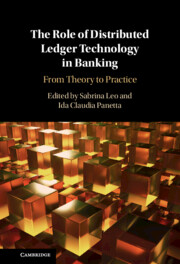Book contents
- The Role of Distributed Ledger Technology in Banking
- The Role of Distributed Ledger Technology in Banking
- Copyright page
- Dedication
- Contents
- Figures
- Tables
- Boxes
- Contributors
- Acknowledgements
- Introduction
- Part I Why Pay Attention to Distributed Ledger Technology in Banking?
- Part II Opportunities and Challenges in Crypto-Asset Regulation
- Part III The Power of Distributed Ledgers in Payments
- 6 DLT in Payments
- 7 Central Bank Digital Currency
- 8 Opportunities, Challenges, and Design of CBDCs
- 9 A Proposal for an Asia Digital Common Currency (ADCC) Applying Distributed Ledger Technology (DLT) and Blockchain Technology (BCT)
- Part IV Enabling Financial Inclusion and ESG with Distributed Ledger Technology
- Part V A Further Look at DLT in Banking: Lessons Learned, Current Applications, and Future Scenarios
- Index
- References
7 - Central Bank Digital Currency
Rationales, Design Considerations, and Implementation Using the Algorand Blockchain Technology
from Part III - The Power of Distributed Ledgers in Payments
Published online by Cambridge University Press: 26 October 2023
- The Role of Distributed Ledger Technology in Banking
- The Role of Distributed Ledger Technology in Banking
- Copyright page
- Dedication
- Contents
- Figures
- Tables
- Boxes
- Contributors
- Acknowledgements
- Introduction
- Part I Why Pay Attention to Distributed Ledger Technology in Banking?
- Part II Opportunities and Challenges in Crypto-Asset Regulation
- Part III The Power of Distributed Ledgers in Payments
- 6 DLT in Payments
- 7 Central Bank Digital Currency
- 8 Opportunities, Challenges, and Design of CBDCs
- 9 A Proposal for an Asia Digital Common Currency (ADCC) Applying Distributed Ledger Technology (DLT) and Blockchain Technology (BCT)
- Part IV Enabling Financial Inclusion and ESG with Distributed Ledger Technology
- Part V A Further Look at DLT in Banking: Lessons Learned, Current Applications, and Future Scenarios
- Index
- References
Summary
In this chapter, we talk about three main topics. We first define the issues that a central bank digital currency (CBDC) could address and the reasons to enhance our understanding of CBDCs. Second, we discuss the optimal design principles of a CBDC as they arose from various conversations with central banks, national and supranational authorities, market participants, and academics in various jurisdictions. Finally, we propose a well-rounded and robust solution for a retail CBDC based on Algorand technology which meets these design principles. Most of the content of this chapter is borrowed from the White Paper Issuing Central Bank Digital Currency Using Algorand by Civelli, Georg, Grassano, and Ihsanullah (2022). In that paper, we extensively cover the CBDC design and issuance topics, informed by our recent participation in various pilots, studies, and round-table conversations on these topics.
- Type
- Chapter
- Information
- The Role of Distributed Ledger Technology in BankingFrom Theory to Practice, pp. 155 - 171Publisher: Cambridge University PressPrint publication year: 2023
References
- 1
- Cited by

